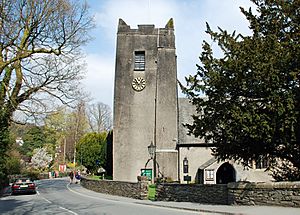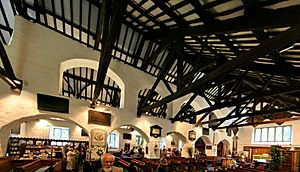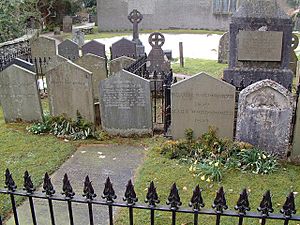St Oswald's Church, Grasmere facts for kids
Quick facts for kids St Oswald's Church, Grasmere |
|
|---|---|

St Oswald's Church, Grasmere, from the south.
|
|
| Lua error in Module:Location_map at line 420: attempt to index field 'wikibase' (a nil value). | |
| OS grid reference | NY 337 074 |
| Location | Grasmere, Cumbria |
| Country | England |
| Denomination | Anglican |
| Website | https://www.achurchnearyou.com/church/12407/ |
| History | |
| Status | Parish church |
| Dedication | Saint Oswald |
| Architecture | |
| Functional status | Active |
| Heritage designation | Grade I |
| Designated | 21 January 1967 |
| Architectural type | Church |
| Style | Gothic |
| Specifications | |
| Materials | Roughcast stone, slate roofs |
| Administration | |
| Parish | Grasmere |
| Deanery | Windermere |
| Archdeaconry | Westmorland and Furness |
| Diocese | Carlisle |
| Province | York |
St Oswald's Church is an active Anglican church located in the beautiful village of Grasmere. This village is found in the famous Lake District area of Cumbria, England. The church is a very important building, listed as Grade I, which means it's historically significant.
It is well-known because of its connections to the famous poet William Wordsworth and his family. The church also holds a special yearly event called rushbearing. St Oswald's is part of the diocese of Carlisle, which is a church area.
Contents
Church History
The church is named after Oswald of Northumbria, a saint from the 7th century who was a King of Northumbria. People believe the church was built on a spot that Saint Oswald himself visited a long time ago.
The building you see today was first built in the 14th century. It was made much bigger between 1490 and 1500. This was done by adding a second main part, called a nave, next to the first one. The roof was rebuilt around 1562. This work added a second row of arches to the inside, making it taller. The windows and doors were repaired and updated in 1840 by an architect named George Webster.
Church Design and Features
St Oswald's Church is built from roughcast stone, which is a type of stone with a rough surface. Its roofs are made of slate. The church has two main sections side-by-side, forming a double nave. It also has a porch on the south side and a tower on the southeast.
The tower's walls lean inwards slightly as they go up, which is called "battered." It has tall, narrow windows called lancet windows and simple pointed tops called pinnacles on its corners.
Inside the church, there's a row of five arches that start from the floor. Above these, there are four more arches. This row of arches, called an arcade, doesn't reach the very top of the roof. Instead, it connects to the strong wooden beams that support the open timber roof.
You can find some interesting old items inside. There's a poor box from 1648, which was used to collect money for people in need. The altar rail, which is a fence-like barrier near the altar, was made in 1725. The pulpit, where sermons are given, is carved with fruits and flowers in a style called Arts and Craft. The font, used for baptisms, is from the medieval period. It has an eight-sided bowl on a stepped base.
The church also has beautiful stained glass windows. One on the north side was made around 1926 by Shrigley and Hunt. Two windows on the south side were created in the 1890s by Henry Holiday. There are also some very old medieval glass pieces in windows on the south side of the chancel, which is the area around the altar.
Memorials and Art
The famous poet William Wordsworth lived in Grasmere starting in 1799. He was buried in the churchyard of St Oswald's. Inside the church, there is a special monument dedicated to him. This monument was created by Thomas Woolner, and it includes a poem written by John Keble.
There is also a stone tablet on the wall in the chancel for Daniel Fleming, a person who studied old things and died in 1701. The church also has a sculpture of the Madonna and child. This artwork was made by Ophelia Gordon Bell, who was an artist who lived and worked in Grasmere.
Church Organ
In the 1870s, St Oswald's Church received an organ made by Wilkinson of Kendal. This organ was later moved to Lancaster. A new organ was installed in 1923. This newer organ was built by Binns of Leeds.
The Binns organ was put in place to remember nurse Nellie Taylor. She sadly passed away in France during the First World War. The organ was recently repaired and updated to celebrate its 100th birthday.
Churchyard and Graves
Wordsworth Family Graves
In the southeast part of the churchyard, there is a special area with twelve graves. These graves are surrounded by railings. This is where members of the Wordsworth family and the Quillinan family are buried. These graves are also listed as Grade II*, meaning they are very important historically.
See also
- Grade I listed churches in Cumbria
- Listed buildings in Lakes, Cumbria



